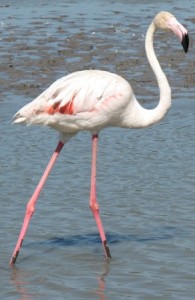 I am still in holiday mode, also a bit tired (tired from a HOLIDAY, shame on me!!!), so I am not doing any research or reading any of the interesting material sent to me by some of you (thanks!). I will in the next few days or so. In the meantime, here is another petit anecdote.
I am still in holiday mode, also a bit tired (tired from a HOLIDAY, shame on me!!!), so I am not doing any research or reading any of the interesting material sent to me by some of you (thanks!). I will in the next few days or so. In the meantime, here is another petit anecdote.
We spent the last three days of our holiday in a glorious bed and breakfast, a lovely 18th century country house with scenic views of the Provençal countryside, just 10 km. from Avignon. Our room was huge, the bed was comfortable, and the views from our bedroom terrace were splendid. Breakfast was served on a large ancient stone-paved terrace shaded by grapevines. Again, lovely views all around.
We planned to tour the Parc Ornithologique of Camargue on Tuesday, the day after we arrived in the Avignon area. We were eager to see pink flamingos and some of the 100 other bird species that nest there during the summer (for more photos, click on Les Oiseaux: http://www.parcornithologique.com/).
I must say, this was definitely a highlight of our entire trip, and I recommend that devoted bird watchers pay a visit to this park if they get the chance. If you go in August, though, let me warn you that parts of the trail around the park are completely unshaded, so come prepared (bring hats and water, mainly). Hot!!!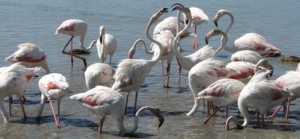
At any rate, early on Tuesday morning, waiting for Stefano to get out of the shower so we could go downstairs for breakfast, I was sitting on our bedroom terrace, enjoying the views, the peace and calm, and the sight of chirpy little birds fluttering hither and thither. Suddenly I heard an incredibly loud clacking/croaking noise…and a few seconds later a huge bird, with the biggest wings and the longest legs I had ever seen in my life, landed on top of a tall pine tree down in the field. 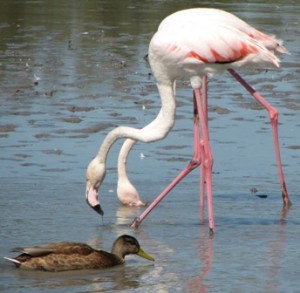 Right in front of me. Stunned, I was unable to move for a moment (this incident occurred before I’d had some coffee, so reflexes were on the slow side…). Unfortunately, by the time I had grabbed my camera, the bird was gone. I got a miserable shot of its big wings flapping in the distance. Not worth posting.
Right in front of me. Stunned, I was unable to move for a moment (this incident occurred before I’d had some coffee, so reflexes were on the slow side…). Unfortunately, by the time I had grabbed my camera, the bird was gone. I got a miserable shot of its big wings flapping in the distance. Not worth posting.
Hopping up and down with excitement, I breathlessly declared to a dripping wet Stefano: I just saw a pink flamingo!
A pink flamingo? Well, he wanted to believe me, but I could tell he was sceptical.
Off we went to have breakfast. In my half-invented but apparently comprehensible French, I described to our hostess what I had seen. Grinning good-naturedly, she informed me that I had actually seen a heron that visited their fish pond at the same time every morning. She went on to reassure me that I would have another chance to take a photo of it. But the heron must have found other early morning feeding grounds in the following two days, since I didn’t see it again.
Mixing up pink flamingos and herons. I suppose that means that my career as a bird watching expert is over…even before it started! ![]()
O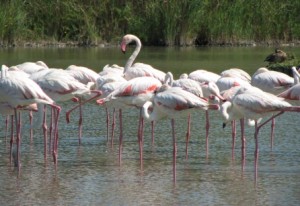 h, this part of the trip was so much fun. It is very entertaining to watch feeding flamingos (see photos 2 and 3; in 2 you can also see a couple of irritated males confronting each other). They dip their heads into the muddy water, then (almost as a group, it seemed to me) raise them, making rather dreadful honking noises and waving them about in the air. Then their heads, upside down so that their beaks can filter micro-organisms out of the water and mud, go back down into the water…again, almost simultaneously. Up, down, up…very odd to watch.
h, this part of the trip was so much fun. It is very entertaining to watch feeding flamingos (see photos 2 and 3; in 2 you can also see a couple of irritated males confronting each other). They dip their heads into the muddy water, then (almost as a group, it seemed to me) raise them, making rather dreadful honking noises and waving them about in the air. Then their heads, upside down so that their beaks can filter micro-organisms out of the water and mud, go back down into the water…again, almost simultaneously. Up, down, up…very odd to watch.
But some of the best shots I got were of sleeping flamingos. 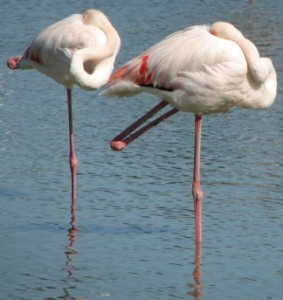 They really do sleep perched on one leg, with the other leg folded up under their bodies and their heads laid over their backs, as you can see in the last two photos.
They really do sleep perched on one leg, with the other leg folded up under their bodies and their heads laid over their backs, as you can see in the last two photos.
Too funny! But puffins are still my favourites…
Freaky facts that I read about flamingos:
-Their eyes are bigger than their brains (fancy that…!).
-Their beaks are referred to as “Roman noses.”
-Their pink colouring is due to the carotene found in their food—algae and small crustaceans. Without carotene, their feathers would be white.
Looks and sounds beautiful Margaret – take your time and bask in your holiday memories. Don’t rush back into ‘Myeloma Mode’ – there’s more to life than research!